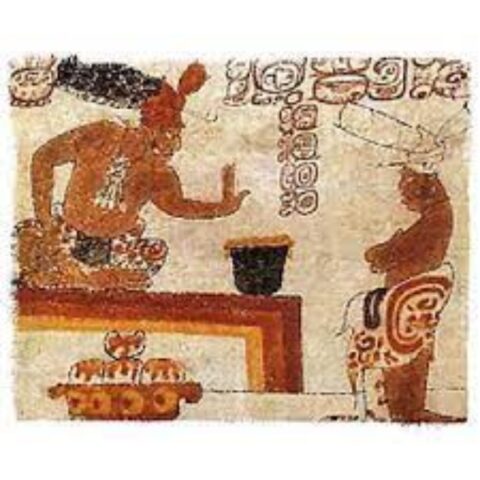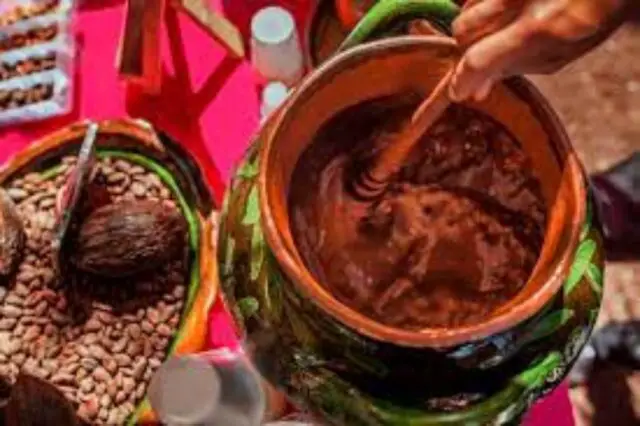Mexico was the country that made cocoa known to the world. The Olmecs (1500 to 400 BC) were the first humans to taste cocoa in the form of a drink in the following way: they ground cocoa beans, mixing them with water, and adding spices, chillies and herbs. The Olmecs were the first to cultivate cacao in Mexico. Over the centuries, the cacao culture spread to the Mayan civilization (600 BC) and the Aztec (1400 BC).
The Mayans used the cocoa pod to create a drink, around the year 600. Similarly, there are several documents that indicate the Aztecs’ predilection for cocoa, the Aztecs prepared a bitter and concentrated concoction called Techocolat, whose consumption was reserved exclusively the emperor, the nobles and the warriors. The cocoa pod was worth more to the natives than gold, and they used it as a bargaining chip for barter. For these civilizations, cacao was a symbol of abundance that was used at the time of religious rituals dedicated to Quetzalcóatl, the Aztec God who carried cacao to men, to Chak Ek Chuah, the Mayan patron saint of cacao. It was also used at the time of the funerals of the elites as an offering.
Xocolatl
In the 16th century when Christopher Columbus arrived in America, the indigenous people drank the well-known “xocolatl“, a drink with a strong flavor that produced great vitality and energy. The cultivation of cocoa in Mexico was widespread at that time throughout the warm and temperate zone of the country. From the province of Tabasco, to Michoacán, Colima, Chiapas and Campeche. It was produced spontaneously, but four main varieties of the plant were also cultivated: Quauhcahuatl, Xochicahuatl and Tlacacahuatl. The most appreciated cocoas were those from the area of Tabasco and Soconusco in Chiapas due to the large size of their seeds for their flavor and smell.
In 1519, Hernán Cortés arrived in Mexico and with a good business sense, Cortés managed to get the Aztecs to exchange gold for cocoa, an indifferent metal for the indigenous people at that time. The Spanish acquired the custom of consuming the chocolate drink just like the Aztecs, with the only difference that they added sugar to it. In one of the letters that Hernán Cortes sent to Carlos V, he assured him that a cup of “xocoatl” was enough to sustain the forces of a soldier for a whole day’s march.

In 1528 Cortés returned to Spain with a shipment of cocoa, in addition to the recipes and utensils necessary for its preparation. The cocoa pods were fermented, dried in the sun, roasted and pressed between two hot stones until obtaining an aromatic paste molded in the form of bars or loaves, then water, sugar or honey and spices were added. Cocoa was considered a medicine, a restorative and even an aphrodisiac. At the same time the recipes were improving, chocolate could be a food or a drink.
For a long time, chocolate was exclusive to Spain and was reserved for privileged social classes. However, smuggling, visitors to the Spanish court, the captures of ships returning from Mexico, were some of the events that allowed cocoa to reach other countries.

Entering Europe
In 1615 it was introduced in France thanks to the royal union of Louis XIII with the Spanish princess Anne of Austria. In 1646 it was introduced in Germany, in 1657 it was introduced in England, where tasting rooms such as the “Cacao Tree” and the “White’s” were opened.
It was in the year 1659 when the first chocolate factory was opened in Paris. In 1697 a Swiss tasted chocolate in Belgium and brought it to his home country in 1711. Cocoa also arrived in Austria through Emperor Charles VI. In 1720 Italian chocolate shops were acclaimed for their high quality. And it was until the year 1765 that chocolate was discovered by the Americans, when they were a colony of England.
Theobroma
Charles Linne was the one who gave the Latin name to cocoa “Theobroma” which means food of the gods. In addition to chocolate, it was used as a medicine for its fortifying and invigorating properties. In 1776 the Frenchman Doret invented a hydraulic machine that could grind cocoa beans into a paste, thus promoting the production of chocolate in large quantities.

Industrialization
Industrialization brought fundamental changes to chocolate, the first chocolate factory was opened in Barcelona Spain in 1780, then Germany and Switzerland followed in the footsteps of Spain by opening more factories.
In 1819, in Paris, Pelletier installed one of the first chocolate factories to use steam. In that year, Fransi Louis Cailler founded the first Swiss chocolate factory in Vevey, Switzerland, and in 1831 Ammédée Kohler founded the second Swiss chocolate factory established in Lausanne. During 1830 and 1879 in Vevey, Switzerland, Henri Nestlé’s laboratory was adjacent to a small chocolate shop created by Daniel Peter.
One day Peter decided to add milk to the chocolate and the world’s first milk chocolate was born. Peter later partnered with Cailler and Kohlr and in 1929 the three brands merged with Nestlé, thus achieving the definitive union of milk chocolate. At the same time Rodolphe Lindt invented melting chocolate.
In 1828, the Dutchman Conrad Van Houten invented a dam that allowed him to extract the fat, that is, the cocoa butter, leaving the cocoa powder that we know today as bitter cocoa. In 1847 England proposed for the first time, thanks to the ingenuity of the House of Fry and Sounds, chocolate in solid form.
In 1893 the confectioner Milton S. Hershey discovered chocolate at a Universal Exhibition in Chicago and began to produce it by opening a factory in Pennsylvania. Faced with the possibility of losing leadership in production, the Swiss decided to produce it on a large scale and bring production centers closer to consumption points; of the world and during the seventies they introduced automated systems that required large investments. Now, new forms and new products are being adapted to the market in all parts of the world to maintain the quality of the chocolate.

